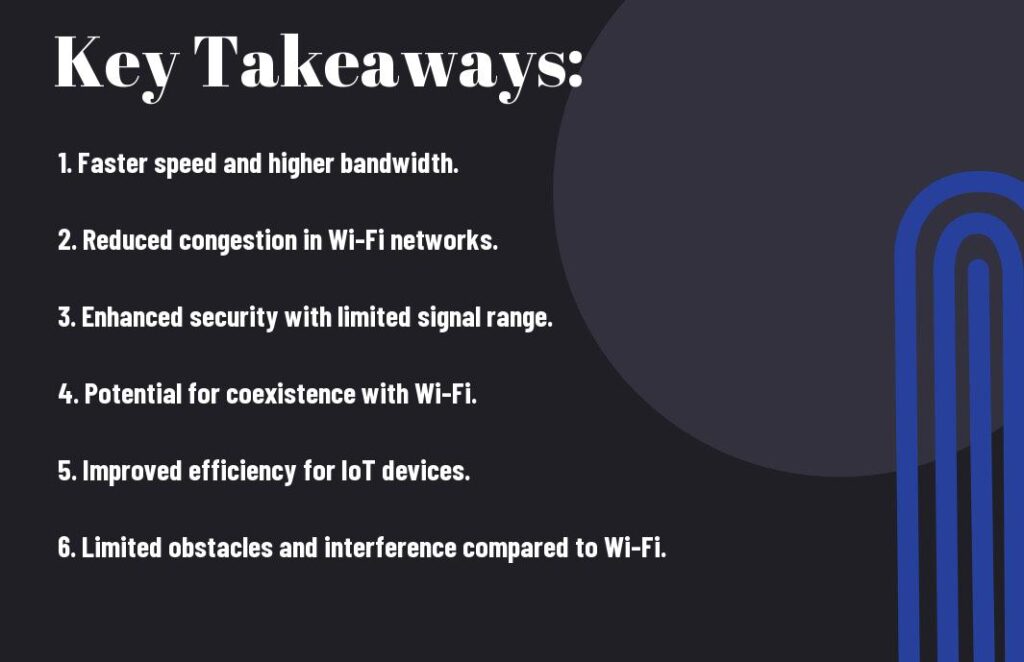Wi-Fi has woven itself into the fabric of our daily existence, serving as the wireless backbone for countless devices. Yet, the emergence of Li-Fi, a technology that leverages light for data transmission and promises speeds that can eclipse traditional Wi-Fi by up to 100 times, introduces thrilling prospects. With the advent of Li-Fi, the “effects of LiFi on WiFi networks” become a pivotal area of inquiry. This innovation not only heralds a new era of connectivity but also prompts a reevaluation of Wi-Fi’s place in our connected world. Through this exploration, we’ll delve into how Li-Fi might influence the realms of speed, security, interference, and device compatibility within existing Wi-Fi ecosystems
Effects Of LiFi On WiFi Networks
Many are curious about the emerging technology of Li-Fi and its potential effects on conventional Wi-Fi networks. Li-Fi utilizes light to transmit data, offering speeds up to 100 times faster than traditional Wi-Fi. This breakthrough could revolutionize industries reliant on fast, stable internet connections. Its key advantage lies in security as signals cannot pass through walls, thus minimizing the risk of unauthorized access. However, the limited range of Li-Fi could pose challenges for widespread implementation in comparison to Wi-Fi networks. Understanding the implications of integrating Li-Fi with existing technology is crucial for adapting to this monumental shift in connectivity.
FAQ
Q: What is Li-Fi and how does it differ from Wi-Fi?
A: Li-Fi, or Light Fidelity, is a wireless communication technology that uses light to transmit data instead of radio waves like Wi-Fi. This means Li-Fi is potentially faster and more secure than traditional Wi-Fi networks.
Q: What impact will Li-Fi have on traditional Wi-Fi networks?
A: Li-Fi has the potential to revolutionize the way we think about wireless communication. It can complement Wi-Fi networks by offloading data traffic in crowded areas, improving network performance, and providing secure connections in environments where radio waves can interfere or be intercepted.
Q: Is Li-Fi widely available and compatible with existing devices?
A: While Li-Fi is still in the early stages of development and deployment, it is not yet widely available or compatible with most existing devices. However, as technology advances and is integrated into more devices and infrastructure, we can expect to see a significant impact on traditional Wi-Fi networks in the near future.
– Key Takeaways:
- Li-Fi’s Impact: Li-Fi technology is expected to complement traditional Wi-Fi networks by providing secure and high-speed wireless connectivity in specific environments.
- Advantages of Li-Fi: Li-Fi offers faster data transfer rates, greater security, and reduced interference compared to Wi-Fi, making it a promising option for certain applications.
- Coexistence with Wi-Fi: While Li-Fi has several advantages, it is unlikely to replace Wi-Fi entirely. Both technologies are expected to coexist and serve different purposes in various settings.

Li-Fi Technology Explained
The introduction of Li-Fi technology into the wireless communication sphere has profound effects on Wi-Fi networks, signaling a pivotal shift in how data is transmitted and received. With its ability to deliver data at speeds vastly superior to Wi-Fi, through light-based communication, the effects of LiFi on WiFi networks underscore a critical juncture for the latter’s infrastructure and operational paradigms. This evolution necessitates an urgent reassessment of Wi-Fi’s capabilities, pushing for innovations in compatibility, efficiency, and enhanced security protocols to ensure Wi-Fi remains a viable and competitive force in our increasingly interconnected world.
– Fundamentals of Li-Fi
Any light source can be used for Li-Fi communication, as long as it can be modulated fast enough to transmit data. LED bulbs are commonly used for Li-Fi, as they can be easily dimmed and brightened to encode data. Light waves can carry significantly more data than radio waves, which enables Li-Fi to offer faster and more secure wireless communication.
– Difference between Li-Fi and Wi-Fi Technologies
Any Li-Fi technology operates on the visible light spectrum, while Wi-Fi uses radio waves on the radio frequency spectrum. Li-Fi can achieve speeds up to 100 times faster than traditional Wi-Fi networks, reaching data rates of several gigabits per second. Additionally, Li-Fi signals cannot penetrate through walls, which means that the network coverage is limited to the area illuminated by the light source.
LiFi technology is also considered to be more secure than Wi-Fi, as light signals do not travel through solid objects, making it harder to intercept data. However, Li-Fi is limited to line-of-sight communication, meaning that users must be within the range of the light source to access the network. This limitation can be both a strength and a weakness, depending on the intended use case.
Implications for Wi-Fi Networks
The advent of Li-Fi technology presents significant implications for existing Wi-Fi networks, potentially reshaping the landscape of wireless communication. With Li-Fi’s promise of faster data transmission and enhanced security due to its light-based communication, Wi-Fi networks may face challenges in maintaining their dominance. This shift could lead to a reevaluation of Wi-Fi’s infrastructure and usage models, pushing for advancements in compatibility, efficiency, and security measures to stay relevant in an increasingly connected world.
– Coexistence and Compatibility
Many experts in the field of wireless communication are closely monitoring the impact of Li-Fi on traditional Wi-Fi networks. To ensure a smooth transition, one of the key considerations is the coexistence and compatibility between these two technologies. While Li-Fi offers high-speed data transmission through light waves, Wi-Fi operates on radio frequencies. Ensuring that these two technologies can coexist without interfering with each other is crucial for the seamless integration of Li-Fi into existing Wi-Fi networks.
Compatibility between the two technologies is also necessary for a smooth user experience. Devices need to be able to switch between Li-Fi and Wi-Fi seamlessly, depending on availability and signal strength. Developing standards and protocols to facilitate this interoperability will be key to the successful adoption of Li-Fi alongside Wi-Fi networks.
– Network Congestion and Spectrum Relief
Many industry experts are exploring the potential impact of Li-Fi on network congestion and spectrum relief in Wi-Fi networks. Implications for network congestion and spectrum relief are significant, as Li-Fi can offload data traffic from conventional Wi-Fi networks onto the light spectrum. This can help alleviate congestion in densely populated areas and provide relief to crowded Wi-Fi frequency bands.
As a result, the adoption of Li-Fi could lead to more efficient utilization of the available spectrum and potentially improve overall network performance. By leveraging light waves for data transmission, Li-Fi has the potential to revolutionize wireless communication and address the growing demands for high-speed connectivity in an increasingly connected world.

Advancements and Limitations
The effects of LiFi on WiFi networks highlight a landscape of advancements and limitations. While LiFi brings groundbreaking speeds and improved security, its reliance on light poses challenges in terms of range and obstacle penetration, contrasting with WiFi’s broader coverage. This dynamic underscores the need for complementary technologies, blending LiFi’s innovations with WiFi’s established connectivity to navigate the future of wireless communication.
– Technological Enhancements in Li-Fi
The advancement of Light Fidelity (Li-Fi) technology has the potential to revolutionize the way we experience wireless communication. The technology uses light waves instead of radio waves to transmit data, enabling faster speeds and increased bandwidth. Li-Fi is capable of achieving data transmission rates that are significantly higher than traditional Wi-Fi networks, making it an attractive alternative for environments where high-speed internet connectivity is crucial.
The ability of Li-Fi to deliver data securely in areas with high radio frequency interference is a significant advantage over Wi-Fi. Li-Fi technology also has the potential to enable more efficient and reliable communication in environments where traditional Wi-Fi networks may face limitations, such as hospitals or aircraft.
– Current Limitations and Challenges for Li-Fi
Limitations and challenges exist for the widespread adoption of Li-Fi technology despite its promising features. One of the primary challenges is the limited range of Li-Fi signals compared to traditional Wi-Fi networks. Li-Fi signals are currently effective only within a relatively short range and can be obstructed by physical barriers, limiting their practical application.
Another limitation is the dependency of Li-Fi on visible light, which means that it may not function optimally in environments with low light levels or where there is no direct line of sight between the transmitter and receiver. Li-Fi technology also faces compatibility issues with existing infrastructure, requiring significant upgrades to fully integrate into current systems.
Limitations Despite these challenges, ongoing research and development in Li-Fi technology show promise in overcoming these limitations and enhancing its potential for various applications. Further advancements in signal range, reliability, and compatibility could position Li-Fi as a viable complement or even a replacement for traditional Wi-Fi networks in the future.
Future Perspectives
Once again, as Li-Fi technology continues to evolve and make strides in the field of wireless communication, it is crucial to consider the future perspectives of this innovative technology. From potential impact on the data transmission industry to integration with existing and future technologies, Li-Fi is poised to revolutionize the way we think about connectivity.
– Potential Impact on Data Transmission Industry
Impact Li-Fi has the potential to disrupt the data transmission industry by offering faster and more secure wireless communication. With its ability to transmit data through light waves, Li-Fi can provide higher bandwidth and reduced interference compared to traditional Wi-Fi networks. This can open up new possibilities for industries that require highly reliable and high-speed data transmission, such as healthcare, finance, and telecommunications.
– Integration with Existing and Future Technologies
On the horizon, Li-Fi technology is expected to integrate seamlessly with existing and future technologies, creating a more interconnected and efficient ecosystem. By combining Li-Fi with Internet of Things (IoT) devices, smart homes, and 5G networks, we can expect a new era of connectivity that is faster, more reliable, and more secure.
Existing infrastructure, such as streetlights and LED bulbs, can be easily retrofitted to support Li-Fi technology, making the transition from Wi-Fi to Li-Fi more feasible and cost-effective. This integration will not only improve data transmission speeds but also pave the way for innovative applications in smart cities, transportation, and industrial automation.
– To wrap up
After all is said and done, Li-Fi technology shows great promise in revolutionizing wireless communication by offering faster speeds, more security, and efficiency in utilizing existing infrastructure. While traditional Wi-Fi networks have their advantages, such as greater range and penetration capabilities, Li-Fi’s potential lies in its ability to complement rather than completely replace Wi-Fi.
Read More: Will Space-based Wireless Internet Satellite Be The Answer To Global Connectivity?
Both technologies can coexist to provide users with more options for connectivity and cater to different needs. As Li-Fi continues to evolve and gain more traction, it is likely to offer a viable alternative for certain use cases, especially in environments where data security and densely populated areas are of prime concern. In the end, Impacts the effects of LiFi on WiFi networks will be more about collaboration and diversification, rather than outright disruption.
***************************

